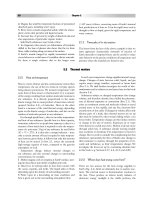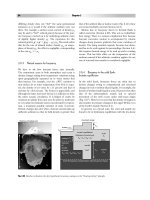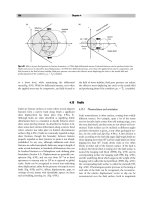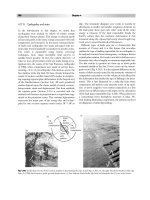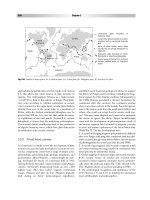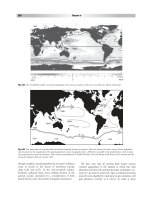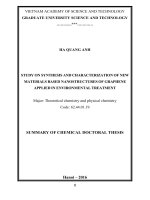Applied and Environmental Microbiology-2021-Michels-AEM.00200-21.full
Bạn đang xem bản rút gọn của tài liệu. Xem và tải ngay bản đầy đủ của tài liệu tại đây (8.01 MB, 51 trang )
AEM Accepted Manuscript Posted Online 14 May 2021
Appl Environ Microbiol doi:10.1128/AEM.00200-21
Copyright © 2021 American Society for Microbiology. All Rights Reserved.
Title: Amino acid analog induces stress response in marine Synechococcus
2
3
Authors: Dana E. Michels1, Brett Lomenick2, Tsui-Fen Chou2, Michael J. Sweredoski2, Alexis
4
Pasulka1*
5
6
1
7
93407, USA
8
2
9
Engineering, California Institute of Technology, Pasadena, CA 91125, USA
Biological Sciences Department, California Polytechnic State University, San Luis Obispo, CA
Proteome Exploration Laboratory, Beckman Institute, Division of Biology and Biological
10
11
*
Corresponding author:
12
13
ABSTRACT
14
Characterizing the cell-level metabolic trade-offs that phytoplankton exhibit in response to
15
changing environmental conditions is important for predicting the impact of these changes on
16
marine food web dynamics and biogeochemical cycling. The time-selective proteome-labeling
17
approach, bioorthogonal noncanonical amino acid tagging (BONCAT), has potential to provide
18
insight into differential allocation of resources at the cellular level, especially when coupled with
19
proteomics. However, the application of this technique in marine phytoplankton remains limited.
20
We demonstrate that the marine cyanobacteria Synechococcus sp. and two groups of eukaryotic
21
algae take up the modified amino acid L-homopropargylglycine (HPG), suggesting BONCAT
22
can be used to detect translationally active phytoplankton. However, the impact of HPG
23
additions on growth dynamics varied between groups of phytoplankton. Additionally, proteomic
1
Downloaded from on May 14, 2021 at CALIFORNIA INST OF TECHNOLOGY
1
analysis of Synechococcus sp. cells grown with HPG revealed a physiological shift in nitrogen
25
metabolism, general protein stress, and energy production, indicating a potential limitation for
26
the use of BONCAT in understanding the cell-level response of Synechococcus sp. to
27
environmental change. Variability in HPG sensitivity between algal groups and the impact of
28
HPG on Synechococcus sp. physiology indicates that particular considerations should be taken
29
when applying this technique to other marine taxa or mixed marine microbial communities.
30
31
IMPORTANCE
32
Phytoplankton form the base of the marine food web and substantially impact global energy and
33
nutrient flow. Marine picocyanobacteria of the genus Synechococcus comprise a large portion of
34
phytoplankton biomass in the ocean and therefore are important model organisms. The technical
35
challenges of environmental proteomics in mixed microbial communities have limited our ability
36
to detect the cell-level adaptations of phytoplankton communities to a changing environment.
37
The proteome labeling technique, bioorthogonal noncanonical amino acid tagging (BONCAT),
38
has potential to address some of these challenges by simplifying proteomic analyses. This study
39
explores the ability of marine phytoplankton to take up the modified amino acid, L-
40
homopropargylglycine (HPG), required for BONCAT, and investigates the proteomic response
41
of Synechococcus to HPG. We demonstrate cyanobacteria can take up HPG, but also highlight
42
the physiological impact of HPG on Synechococcus, which has implications for future
43
applications of this technique in the marine environment.
44
45
2
Downloaded from on May 14, 2021 at CALIFORNIA INST OF TECHNOLOGY
24
47
INTRODUCTION
Phytoplankton are critical components of marine ecosystems, accounting for half of the
48
planet’s primary productivity and influencing global nutrient cycling (1, 2). Ecological trade-offs
49
exhibited by marine phytoplankton to maximize growth (e.g., compete for nutrients) and
50
minimize loss (e.g., increase predation defenses) shape phytoplankton diversity and community
51
structure in the ocean, which in turn significantly impacts food web dynamics and
52
biogeochemical cycling (3). A cell-level approach is necessary to elucidate how these important
53
organisms allocate resources, especially in response to changing environmental conditions.
54
The advent of ‘omics approaches has revolutionized our ability to describe marine
55
phytoplankton communities and their mechanisms of adaptation to changing environments at the
56
cellular level (4). Proteomic approaches allow for the detection of real-time changes in
57
phytoplankton physiology and metabolic state because they provide a deep insight into the
58
changes of a large fraction of the entire protein complement of the cell. Proteomics offers an
59
advantage over transcriptomics in that not all transcripts are translated into functional proteins.
60
However, due to the complexity of marine proteomes, there are challenges when applying these
61
tools to explore natural communities (5). The time-selective proteome-labeling approach,
62
bioorthogonal noncanonical amino acid tagging (BONCAT), has the potential to address some of
63
these challenges. BONCAT relies on pulse-labeling organisms with noncanonical amino acids
64
(NCAAs) like the methionine (Met) surrogate L-homopropargylglycine (HPG), such that
65
NCAAs get incorporated into nascent proteins by the cell’s endogenous translational machinery
66
(6, 7). While a number of modified amino acids successfully compete with native amino acids,
67
few are able to exploit the promiscuity of the endogenous translational machinery without
68
modification to the host cell (8). Met analogs are particularly useful because the enzyme that
3
Downloaded from on May 14, 2021 at CALIFORNIA INST OF TECHNOLOGY
46
catalyzes the esterification of Met with its tRNA, methionyl-tRNA synthetase, has low
70
specificity causing misrecognition and misincorporation of such analogs in place of methionine
71
(9). Met analogs can even serve as the initiator of translation without disruption of the
72
translational machinery (10). BONCAT has been applied successfully to visualize and identify
73
translationally active cells in natural communities (11). Furthermore, the BONCAT technique
74
offers the ability to separate the labeled proteome from the bulk proteome by exploiting the
75
chemical handle of the NCAA incorporated into the newly synthesized proteins, thereby
76
simplifying proteomic analysis and reducing challenges often encountered in natural proteomics
77
(12, 13).
78
BONCAT has been applied in a variety of cultured microorganisms and ecosystems (6, 7,
79
14), but its use in marine planktonic microbial communities has been limited. Initial studies
80
demonstrated uptake of NCAAs by marine heterotrophic bacteria and the ability to quantify
81
protein synthesis rates in natural populations (15, 16). Two additional studies showed uptake of
82
NCAAs by the eukaryotic phytoplankton Emiliania huxleyi (17) and the heterotrophic
83
flagellate Cafeteria burkhardae (18). However, none of these studies have moved beyond the
84
visualization of NCAA uptake via fluorescence microscopy to capture the protein-level
85
physiological response of these marine microbial populations. The BONCAT approach,
86
particularly when coupled with proteomics, has potential to provide insight into the differential
87
allocation of resources at the cellular level, allowing us to explore the trade-offs marine
88
microorganisms make in response to changing environmental conditions.
89
A major assumption of the BONCAT approach is that the uptake and utilization of
90
NCAAs by cells does not impact cellular physiology. Most studies report that additions of
91
NCAAs have minimal impact on cells when examined by microscopy (17, 19, 20). At the protein
4
Downloaded from on May 14, 2021 at CALIFORNIA INST OF TECHNOLOGY
69
level, no changes to protein expression or degradation were observed due to NCAA additions
93
(human embryonic kidney cells; 7 and E. coli; 14); however, one study reported alterations to
94
protein abundance (Vibrio harveyi; 9). Recent work demonstrated that NCAAs cause mild
95
perturbations to the metabolome of E. coli and that this impact was intensified when NCAAs
96
were added under stressful conditions (e.g., heat stress; 21). However, our understanding of the
97
limited impact of NCAAs on cells comes mostly from studies involving heterotrophic bacteria
98
and these assumptions may not be valid for autotrophic phytoplankton. To address this
99
knowledge gap, we explored the use of BONCAT in Synechococcus sp., a globally important
100
marine cyanobacteria. We characterized the growth of Synechococcus sp. under a range of HPG
101
concentrations and optimized the fluorescence signal to detect this uptake via epifluorescence
102
microscopy. In addition, we examined changes in protein expression of Synechococcus sp.
103
grown with HPG under normal and nitrate-stressed conditions relative to a non-HPG control.
104
Finally, we characterized the growth and quantified HPG uptake under a range of HPG
105
concentrations in two eukaryotic phytoplankton models, Ostreococcus sp. and Micromonas
106
pusilla, to test whether they exhibited the same initial sensitivity to HPG additions as
107
Synechococcus sp.
108
109
110
RESULTS
111
Impact of HPG concentration on phytoplankton growth dynamics
112
Phytoplankton exhibited different sensitivities to HPG concentration. For both eukaryotic
113
green algal models (M. pusilla and Ostreococcus sp.), growth in the presence of HPG was
114
similar to that exhibited in the negative (e.g., non-HPG) control for all HPG concentrations
5
Downloaded from on May 14, 2021 at CALIFORNIA INST OF TECHNOLOGY
92
tested (up to 100 µM; Figure 1A, B). However, for Synechococcus sp., HPG concentrations as
116
low as 25 µM disrupted normal growth dynamics (Figure 1C). Compared to the maximum
117
growth exhibited by the negative control, 25 µM HPG additions reduced Synechococcus sp.
118
growth by 39%, whereas 50 µM HPG additions reduced growth by 51%. 100 µM HPG
119
concentrations (the concentration used in previous studies with marine heterotrophic bacteria in
120
culture; 13) resulted in a complete crash of the Synechococcus sp. culture (data not shown).
121
Synechococcus sp. grew normally and reached the same maximum growth when exposed to 10
122
µM HPG and lower concentrations. Synechococcus sp. growth with 10 µM HPG additions was
123
characterized three additional times to confirm this result (data not shown).
124
125
Fluorescence detection of BONCAT signal
126
Epifluorescence microscopy was used to detect and visualize HPG incorporation by the
127
phytoplankton from HPG-growth experiments using the highest HPG concentration that did not
128
alter cell growth dynamics (Figure 1; 100 µM for M. pusilla and Ostreococcus sp. and 10 µM for
129
Synechococcus sp.). As outlined in the methods section Microscopy and Image Analysis,
130
heterotrophic bacteria present in the cultures were excluded from the data prior to interpretation
131
of HPG incorporation by the phytoplankton cells (Figures S1 and S2). While the proportion of
132
bacteria in the cultures could not be determined for Ostreococcus sp. and M. pusilla (because
133
bacteria were visually removed during ROI selection), the proportion of bacteria present in
134
Synechococcus sp. cultures over multiple experiments ranged from 17-23% of the population.
135
For all taxa, the fluorescence signal in the blue (e.g., DAPI-stained cells) and red or
136
orange (e.g., autofluorescence from phytoplankton pigments) channels were consistent between
137
the negative and positive treatments, providing visual evidence that the cells appeared healthy
6
Downloaded from on May 14, 2021 at CALIFORNIA INST OF TECHNOLOGY
115
and intact when grown in the presence of HPG (Figures 2,3,4). A bright signal in the green
139
channel (e.g., fluorescence signal of the azide-containing CR-110 fluorophore) was visually
140
apparent in cultures amended with HPG relative to negative control cultures (Figures 2,3,4).
141
Quantitative analysis based on the green fluorescence intensity revealed that the HPG-amended
142
treatments (positive) were significantly different from the negative controls for all phytoplankton
143
models across all time-points (Mann-Whitney U Test; Table S1, Figure 5). However, it is
144
important to note that while Synechococcus sp. cells grown with HPG were still brighter in
145
comparison to HPG negative cells, these cells exhibited some autofluorescence in the green
146
channel due to the presence phycobiliproteins hence the greater overlap in the signal between the
147
positive and negative treatments (Figure 2, 5C). M. pusilla exhibited the strongest fluorescence
148
signal as a result of HPG incorporation at 48 h (Figure 5A). In contrast, the fluorescence signal
149
as a result of HPG incorporation (e.g., CR-110) in Synechococcus sp. and Ostreococcus sp.
150
increased over time (Figure 5B, C) and exhibited the strongest fluorescence relative to the
151
negative control at 72 h post HPG addition.
152
153
Physiological response of Synechococcus sp. to HPG additions under replete and nutrient-
154
limited conditions
155
Following resuspension of cultures in the appropriate treatment media with HPG (Table
156
2), replete cultures exhibited a typical growth rate, while nitrate-limited cultures exhibited a
157
reduced growth rate (Figure 6). Control cultures (e.g., no spin conditions, no HPG) continued to
158
increase exponentially. Epifluorescence microscopy revealed consistent fluorescence signals in
159
the blue (e.g., DAPI-stained cells) and orange (e.g., autofluorescence from phycobiliproteins
160
pigments) channels across treatments and time points. However, green fluorescence intensity
7
Downloaded from on May 14, 2021 at CALIFORNIA INST OF TECHNOLOGY
138
(fluorescence signal of the azide-containing CR-110 fluorophore) was visually brighter for both
162
replete and nitrate-limited HPG-amended treatments compared to the control (Figure 7). This
163
visual difference in green fluorescence intensity was quantitatively and significantly different in
164
HPG-amended treatments (replete and nitrate-limited) relative to the control across both time-
165
points (Table S2, Figure S1).
166
Proteomic analysis collected 22,209 MS2 spectra, from which 5,969 peptide-to-spectrum
167
matches and 5,551 peptide groups were identified. A total of 1,033 proteins were identified,
168
(representing about 36% of all predicted proteins in Synechococcus sp. strain CC9311; 19) and
169
496 quantified proteins were used for analysis after filtering (see Methods section ‘Proteomics’).
170
HPG labeling was detected in 68 of the final quantified proteins. Relative to the negative control,
171
222 proteins had significantly different expression (i.e., a minimum log2 fold-change of 1 and an
172
adjusted p-value less than 0.05) in the HPG positive treatments relative to the negative control
173
(Figure 8, Table S3). Of these proteins, 122 were up-regulated and 100 were down-regulated.
174
HPG labeling was detected in 25 of these significant proteins (Table S5). The proteins
175
differentially expressed in the nitrate-limited condition vs. the control had a greater median log2
176
fold-change value than the proteins differentially expressed in the nitrate-replete condition vs.
177
the control (Figure S2), suggesting that the added stress of nitrate limitation magnified the
178
proteomic changes caused by HPG treatment.
179
Proteomic analysis revealed that HPG influenced several aspects of metabolism including
180
nitrogen metabolism, general protein stress, and energy production (Table 3). Glutamate
181
synthetase (ferredoxin-dependent glutamate synthase, Fd-GOGAT) and glutamine synthetase
182
(glnN) were significantly upregulated in HPG-treatments compared to the control. Chaperonin
183
proteins (groEL1, groEL2, dnaK and htpG) and a probable cytosol aminopeptidase (pepA) were
8
Downloaded from on May 14, 2021 at CALIFORNIA INST OF TECHNOLOGY
161
also significantly upregulated in HPG treatments. Many antenna proteins were upregulated in
185
HPG treatments, including phycobilisome linker polypeptides (cpcC, cpcD, cpeC, cpeD1,
186
cpeD2), phycobilisome rod-core linker polypeptides (cpcG1, cpcG, apcE), allophycocyanin
187
apoproteins (apcB1, apcD), and phycoerythrin chain peptides (cpaA2, cpaB1, cpaB2). Two other
188
antenna proteins (cpeT, cpeS) were significantly downregulated in HPG treatments relative to
189
the control. Major components of photosystem I were upregulated in HPG treatments relative to
190
the control, including psaA, psaB, psaC, psaD, psaF, and psaL. Some proteins of photosystem II
191
were also upregulated (psbC, psbJ, psbW and psbV). Two major proteins of ATP synthase were
192
upregulated (atpH and atpF), while one protein was downregulated (atpD). Many peptides
193
related to the phycobilisome and photosystem I were labeled with HPG including, ferredoxin,
194
psaC, psaF, cpcD, cpa2, cpaB1, and cpaB2. Additionally, one of the ATP synthase F1
195
subcomplex beta subunits (atpD) was HPG labeled. The antioxidant proteins peroxiredoxin and
196
thioredoxin-dependent thiol peroxidase, prx and prxQ, respectively were also upregulated in
197
HPG treatments.
198
When comparing protein expression between the two HPG positive treatments (nitrate-
199
replete vs. nitrate-limited), 14 proteins were significantly different between these two groups. Of
200
these proteins, 4 were up-regulated and 10 were down-regulated (Table S5). HPG labeling was
201
detected in 4 of these significant proteins. However, for 13 of these 14 proteins, the directionality
202
of the log2 fold-changes for this pairwise comparison was the same as the directionality in the
203
pairwise comparison of HPG positive treatments relative to the control. Therefore, the
204
identification of these proteins as being differentially expressed between nitrate-replete vs.
205
nitrate-limited treatments largely reflects the greater magnitude of log2 fold-change values in the
206
nitrate-limited treatment rather than a meaningful biological difference in the proteome of the
9
Downloaded from on May 14, 2021 at CALIFORNIA INST OF TECHNOLOGY
184
two conditions (Table S5, Figure S2). These proteins predominantly indicate that when a cell is
208
under nutrient stress, the addition of HPG exhibits a greater interference on nitrogen metabolism
209
(upregulation of the nitrogen-responsive regulatory protein [ntcA] and glutamine synthetase [GS]
210
and downregulation of ferredoxin-nitrite reductase [Fd-nir]) and energy production (upregulation
211
of NADH dehydrogenase and downregulation of light-independent protochlorophyllide
212
reductase iron-sulfur ATP-binding protein [chlL]; TableS5).
213
214
215
DISCUSSION
216
The BONCAT technique has helped scientists begin to address key questions in
217
microbial ecology. This approach provides a tool to link microbial function with phylogeny by
218
identifying translationally active cells in cultures and natural communities (14, 16). BONCAT
219
has recently been applied to study marine bacterioplankton and obtain single-cell protein
220
synthesis rates (15), but its use in marine phytoplankton communities remains limited. When
221
coupled with proteomics, this technique has the potential to help elucidate the mechanisms by
222
which marine microorganisms adapt and survive in changing environmental conditions (e.g.,
223
Pseudomonas aeruginosa, 13; Vibrio harveyi, 23). In this study we demonstrate that the marine
224
cyanobacteria Synechococcus sp. and two groups of eukaryotic algae can take up the modified
225
amino acid, HPG. Overall, our findings suggest that BONCAT can be used to detect
226
translationally active phytoplankton. However, among different phytoplankton groups, we
227
observed variability in how HPG impacted normal growth dynamics (Figure 1). Furthermore,
228
despite normal growth patterns when exposed to 10 µM HPG concentrations, variations in
229
protein expression between Synechococcus sp. in HPG treated cultures vs. non-HPG control
10
Downloaded from on May 14, 2021 at CALIFORNIA INST OF TECHNOLOGY
207
cultures revealed an influence of HPG on cyanobacterial cell physiology (Figure 8). Therefore,
231
the ability to use BONCAT as a tool for understanding the cell-level response to stressors may be
232
limited in Synechococcus sp. and other cyanobacteria.
233
While there is evidence to suggest that some phytoplankton take up amino acids, the field
234
lacks consensus on the prevalence, rates, and occurrences of amino acid uptake as well as the
235
importance of these amino acids as a nitrogen source for phytoplankton (24, 25). Visualization of
236
fluorescently-labeled cells after exposure to HPG suggest that the phytoplankton tested in this
237
study have the ability to take up free amino acids (Figures 2, 3, 4, 5). This finding is consistent
238
with previous work demonstrating that the coccocolithophorid Emiliania huxleyi and marine
239
flagellate Cafeteria burkhardae can take up HPG (17, 18), and that Synechococcus sp. can take
240
up organic compounds including amino acids (27, 28). Laboratory studies with cultured
241
organisms have demonstrated that some phytoplankton can grow successfully on certain amino
242
acids as a sole nitrogen source (28, 29), but conclusions from field studies with natural
243
populations have been more variable (25, 29). However, studies on marine picocyanobacteria
244
have shown natural population take up various amino acids (30-34). While most studies assume
245
amino acids are taken up intact, some phytoplankton possess enzymes that oxidize L-amino acids
246
at the cell surface to obtain ammonium for cellular uptake (29, 34). These cell surface
247
deaminases are responsible for decomposing amino acids, effectively separating the nitrogen
248
source from the carbon backbone and allowing for uptake (36). Therefore, further work is needed
249
to examine amino acid uptake mechanisms for different groups of phytoplankton such that we
250
can determine if this technique can be more broadly applied to natural phytoplankton
251
communities.
11
Downloaded from on May 14, 2021 at CALIFORNIA INST OF TECHNOLOGY
230
Overall, these culture-based experiments revealed that phytoplankton exhibit varied
253
sensitivities to HPG concentration (Figure 1). The micro-eukaryotes Ostreococcus sp. and M.
254
pusilla appeared to be less sensitive to HPG than Synechococcus sp., such that their growth (as
255
measured via spectrophotometry) was not inhibited by HPG concentrations as high as 100 µM
256
(Figure 1A, B). The decrease in growth observed in Synechococcus sp. at 25 µM HPG
257
concentrations suggests that this group experienced physiological perturbations with the addition
258
of this modified amino acid (Figure 1C). Very few studies have actually investigated the impact
259
of HPG on an organism’s cellular physiology. Recent work by Steward et al. (21) revealed that
260
HPG additions caused a shift in the metabolome of E. coli that was intensified by heat stress.
261
However, different ecosystems and organisms are likely to have varied sensitivities to HPG
262
additions; therefore, knowledge from one model organisms (e.g., E. coli), may not be applicable
263
to other model organisms or ecosystems. In this study, we found that Synechococcus sp. cells
264
exposed to 10 µM HPG exhibited protein-level changes to nitrogen metabolism, general protein
265
stress, and energy production (Figure 8, Table 3), even though growth was not inhibited until the
266
cells were exposed to 25 µM of HPG. In agreement with Steward et al. (21), the changes in
267
protein expression caused by HPG were intensified (greater log2 fold-change) when the cells
268
were under nutrient stress (Figure S2). Interestingly, many of the proteins that had significantly
269
altered expression were also labeled with HPG (Table 3). Furthermore, HPG-labeled proteins
270
predominantly occurred within structural complexes (e.g., ATP synthase, phycobilisome).
271
However, it is important to note that due to the strong correlation between protein abundance and
272
sequence coverage obtained in bottom-up proteomics (37), we are more likely to see HPG
273
incorporation in higher abundance proteins (e.g., structural and metabolic housekeeping genes).
274
At this time, it is unclear whether the increased expression of proteins in HPG-treated cells
12
Downloaded from on May 14, 2021 at CALIFORNIA INST OF TECHNOLOGY
252
would lead to increased products and affect metabolic pathways, or whether the HPG-
276
substitutions caused structural or functional issues with those proteins. In the latter case, the
277
increased expression could have resulted from the cells replacing polypeptides in malfunctioning
278
HPG-labeled proteins, particularly for key structural complexes. Below, we explore the
279
metabolic consequences of HPG addition to Synechococcus sp. cells based on significant
280
changes we detected at the protein level.
281
The upregulation of glutamine synthetase (GS) and glutamate synthetase (GOGAT) in
282
HPG-treated cultures (Table 3) indicates potential inhibition of these enzymes by HPG and
283
therefore key nitrogen cycling processes in the cell. In cyanobacteria, ammonium is incorporated
284
into carbon skeletons by the GS/GOGAT cycle (38). Glutamate and glutamine produced in this
285
cycle play important roles in the distribution of nitrogen throughout the cell to other nitrogenous
286
compounds. Glutamate is not only the direct precursor for some amino acids and 5-
287
aminolevulinate (the immediate precursor for phycobilin, chlorophyll and porphyrin
288
biosynthesis), but it also functions as the primary nitrogen donor for the synthesis of other
289
nitrogen-containing metabolites (38). Specific inhibition of glutamine synthetase is well-
290
documented in another strain of Synechococcus sp. by doping with the NCAA, L-methionine-
291
sulfoximine (MSX; 39, 40). When ammonium was provided as the sole nitrogen source, MSX
292
acted as a specific inhibitor of GS thereby inhibiting ammonium assimilation, essentially
293
mimicking nitrogen starvation (40). This evidence of MSX’s functioning in other Synechococcus
294
sp. strains supports the idea that HPG may be inhibiting these critical enzymes of nitrogen
295
cycling in Synechococcus sp.
296
297
A general stress response, with particular evidence for protein stress, in the presence of
HPG was indicated by the upregulation of chaperonins. The upregulation of chaperonins is well-
13
Downloaded from on May 14, 2021 at CALIFORNIA INST OF TECHNOLOGY
275
documented as part of the core general stress response in cyanobacteria (41). Chaperonin
299
proteins are thought to transiently bind polypeptides that have been forced to take non-native
300
conformations under stressful conditions. Through this binding, chaperonins function to
301
temporarily hold the non-native polypeptides and prevent aggregation in the crowded
302
environment of the cell (41). Chaperonins with increased expression in HPG dosed
303
Synechococcus sp. cells included groEL (1 and 2), dnaK, and htpG (eukaryotic homologs are
304
heat shock proteins hsp60, hsp70 and hsp90, respectively; 38; Table 3). DnaK also functions to
305
solubilize aggregates of partially denatured proteins and rescue the polypeptides (41).
306
Additionally, upregulation of the cytosol aminopeptidase (pepA), which is involved in protein
307
regulation and turnover indicates cellular stress, as this protein is upregulated in E.coli under heat
308
stress (42). Together, the significant upregulation of this suite of proteins provides evidence that
309
HPG additions lead to protein misfolding and stress in Synechococcus sp. cells.
310
Collectively the upregulation of proteins associated with the light harvesting capacity of
311
Synechococcus sp. (phycobilisome antenna proteins and photosystem I) and oxidative
312
phosphorylation indicate that cells are experiencing an interference with energy production under
313
HPG addition (Table 3). The phycobilisome is the major light harvesting apparatus of
314
cyanobacteria. This highly ordered supramolecular complex is made up of linker polypeptides
315
and phycobiliproteins with unique spectral properties (phycoerythrin [PE, Amax = 560 nm],
316
phycocyanin [PC, Amax = 620 nm] and allophycocyanin [AP, Amax = 650 nm]; 33). Linker
317
polypeptides stabilize the phycobilisome structure and ensure optimal functioning by
318
encouraging unidirectional flow of energy from the periphery to the core, and later to the
319
photosynthetic reaction center (43, 44). The upregulation of many proteins related to the
320
phycobilisome, especially linker polypeptides, indicates potential instability or disfunction of the
14
Downloaded from on May 14, 2021 at CALIFORNIA INST OF TECHNOLOGY
298
phycobilisome in HPG treated cells. This upregulation could also indicate attempts to increase
322
light harvesting capacity for energy production in cells treated with HPG. Additionally, some of
323
the antenna proteins related to phycoerythrin (cpa2, cpaB1 and cpaB2) that were significantly
324
upregulated in HPG treatments were also labeled with the NCAA. The hptG protein was also
325
significantly upregulated in HPG dosed treatments, providing evidence of non-native protein
326
folding or aggregation of linker polypeptides in HPG treated cells. Interestingly, the stress
327
response chaperonin, htpG, has been shown to interact with and stabilize a 30 kDa rod linker
328
polypeptide of the phycobilisome in a different strain of Synechococcus (45). Together, the
329
observed changes to phycobilisome-related proteins indicates potential issues in stability or
330
function of the major light harvesting complex in HPG treated Synechococcus sp.
331
Photosystem I (PS I) in cyanobacteria is a light driven reaction center that changes the
332
energy of a photon into free chemical energy though oxidation of cytochrome c6 or plastocyanin
333
and reduction of ferredoxin or flavodoxin (46). Major components of PS I that were upregulated
334
in HPG treatments relative to the control included psaA and psaB (heterodimer of the integral
335
reaction center), psaC (which provides a path for the electrons out of the membrane phase and to
336
the stromal phase, allowing ferredoxin to be reduced with high quantum efficiency), psaD
337
(which docks ferrodoxin or flavodoxin), psaF (which docks plastocyanin or cytochrome c6), and
338
psaL (the connecting protein for PS I trimers and state transitions). While the cause of
339
Synechococcus sp. upregulating these critical PS I proteins in the presence of HPG remains
340
unknown, we hypothesize this is due either to an attempt to increase the energy production by
341
this reaction center or to cope with structural or functional issues caused by HPG substitution.
342
A series of electron transfer reactions harvest energy in cyanobacteria to create a
343
transmembrane electrochemical proton gradient that is used to drive the synthesis of ATP by an
15
Downloaded from on May 14, 2021 at CALIFORNIA INST OF TECHNOLOGY
321
F-type ATPase, allowing energy to be temporarily stored and easily accessed by many enzymes
345
through the cell (47). ATP synthase genes examined in select cyanobacteria are arranged in two
346
gene clusters, atp1 (codes genes atpI-atpH-atpG-atpF-atpD-atpA-atpC) and atp2 (codes
347
remaining genes atpB-atpE; 48). Two major proteins of cluster 1 were upregulated (atpH and
348
atpF), while the following protein was downregulated and also labeled with HPG (atpD),
349
indicating that in the presence of HPG, Synechococcus sp. are likely experiencing interference
350
with this important energy production complex.
351
The disruption to normal energy production systems described above suggests that HPG
352
could indirectly cause oxidative stress in Synechococcus sp. Oxygen is a powerful electron
353
acceptor yet its intermediates, which are generated through photosynthesis and electron
354
transport, can have highly damaging effects on metabolic networks (49). Imbalances in the
355
generation of reactive oxygen species and antioxidant responses, lead to oxidative stress, which
356
commonly occurs due to environmental stressors (e.g., UV stress, nutrient stress). The
357
upregulation of two antioxidant proteins, peroxiredoxin (prx) and thioredoxin-dependent thiol
358
peroxidase (prxQ), which are important proteins for maintaining redox homeostasis in
359
Synechococcus sp., provide evidence of redox imbalance in HPG treated cells (50, 51).
360
Overexpressed prxQs have shown protection from oxidative stress in cyanobacteria (51). Overall
361
changes to light harvesting and energy production pathways in concert with upregulation of
362
antioxidant proteins indicates that HPG may indirectly cause oxidative stress in Synechococcus
363
sp.
364
Phytoplankton experience a consistently changing set of environmental conditions in the
365
ocean (52). Therefore, investigating the impact of NCAAs on microbial populations in
366
conjunction with an environmental stressor provides a more realistic evaluation of the technique
16
Downloaded from on May 14, 2021 at CALIFORNIA INST OF TECHNOLOGY
344
(21). Populations of marine cyanobacteria are especially influenced by nutrient availability (53,
368
54) and as such, nitrate limitation was a physiologically appropriate stressor to test in
369
combination with NCAA additions. Further, there is supporting literature at the transcript level
370
describing the response of Synechococcus sp. to nitrate stress (55, 56). These transcript level
371
responses typically include the reduction of photopigments and photosynthetic capacity as well
372
as the upregulation of the nitrogen control regulator genes (56). Ideally, this investigation would
373
have led to a better protein-level understanding of nitrate stress in Synechococcus sp. However,
374
the inference with nitrogen cycling (as well as other core stress responses) induced by the
375
addition of HPG, limits our ability to determine if the protein expression in nitrate-limited cells
376
can be attributed to nitrogen stress or if the nitrogen stressed cells were more susceptible to the
377
issues induced by HPG additions. Therefore, follow up experiments without HPG could provide
378
insight into the protein-level responses of Synechococcus sp. to environmental stressors and
379
allow for better comparison of the protein and transcript-level responses.
380
Metabolic labeling of proteins with NCAAs provides a unique tool for characterizing
381
translationally active microbial communities (14). However, if HPG directly impacts the
382
physiology of cells, as we demonstrate here for Synechococcus sp., the use of this technique to
383
elucidate the protein-level physiological response of microorganisms to changing environmental
384
conditions may be limited. While Synechococcus sp. treated with 10µM of HPG exhibited the
385
same growth dynamics as non-HPG controls (Figure 1C), we observed significant and
386
potentially detrimental changes in important pathways (Table 3). At this time, it is unclear if and
387
how these protein-level changes translated into altered metabolic rates, since growth under this
388
concentration of HPG appeared normal. However, these effects were likely intensified at higher
389
concentrations of HPG, such that when exposed to 25 µM of HPG, Synechococcus sp. did
17
Downloaded from on May 14, 2021 at CALIFORNIA INST OF TECHNOLOGY
367
exhibit a reduction in growth. These findings highlight the importance of coupling HPG
391
additions with several biologically relevant rate measurements (e.g., growth, photosynthetic
392
efficiency) to determine if and to what extent HPG alters metabolic rates. When applied in a
393
natural setting, these types of HPG-induced effects could alter interactions between organisms.
394
For example, in the marine environment, there is close coupling between phytoplankton and
395
heterotrophic bacterial growth dynamics (57, 58), because heterotrophic bacterial growth in the
396
euphotic zone is strongly influenced by phytoplankton-derived dissolved organic matter (59-61).
397
Marine Synechococcus sp. and heterotrophic bacteria are known to be spatially and ecologically
398
intimate in natural settings and in culture, frequently conjoining or forming networks (62, 63).
399
Given the tight interaction of these organisms, both physically and for essential carbon and
400
nutrients, changes in one organism’s physiology, (e.g., Synechococcus sp.) in response to HPG,
401
could have cascading effects on the heterotrophic bacteria that exist in community with those
402
cells.
403
The BONCAT technique lends itself to investigating a wide range of ecological
404
questions. Therefore, if the goal of the study is to visualize and sort translationally active marine
405
microorganisms (64) this technique may be appropriate. In contrast, if the goal of the application
406
is to characterize and track the physiology and proteomic response of marine microorganisms
407
including cyanobacteria to changing environmental conditions, this approach may not be
408
appropriate. It is however, important to recognize that the HPG concentrations used in this study
409
were meant to maximize fluorescence intensity in order to detect HPG uptake in cyanobacteria.
410
These higher concentrations may not always be necessary for other ecosystems and ecological
411
questions. Additionally, it would be worth exploring other commonly used NCAAs, such as L-
412
azidohomoalanine (AHA), in these types of sensitivity experiments. AHA has been applied to an
18
Downloaded from on May 14, 2021 at CALIFORNIA INST OF TECHNOLOGY
390
equally wide range of study systems (7, 20, 65-67) and demonstrates potentially less toxicity and
414
disturbance to the physiology of the study system (21), although its impact has not been
415
investigated at the proteomic level. Overall, our results highlight an imperative aspect of
416
investigation for studies utilizing HPG to ensure the NCAA addition does not influence cell
417
metabolism. Different taxa are likely to show varying sensitivities to NCAA additions and these
418
considerations must be taken into account when applying this approach to study marine
419
microbial communities.
420
421
422
METHODS
423
Culture conditions
424
Experiments were conducted with three different algal cultures including one
425
cyanobacteria and two green algae – Synechococcus sp. (strain CC9311; CCMP3074; 68),
426
Micromonas pusilla (CCMP487) and Ostreococcus sp. (MBIC10636), respectively. Cultures
427
were maintained in L1 medium minus silica (69) using salt solutions from ESAW Medium rather
428
than filtered natural seawater (70, 71). Cultures were maintained in an incubator at 18C on a
429
12:12 h light:dark cycle, however, Ostreococcus sp. and M. pusilla were grown under higher
430
light (75 µmoles photons m-2 s-1) relative to Synechococcus sp. (20-25 µmoles photons m-2 s-1).
431
All cultures were transferred and maintained under sterile conditions, but were not axenic.
432
Heterotrophic bacteria were present, but in low densities relative to the algal strains (see Results
433
section Microscopy and Image Analysis for details).
434
435
HPG sensitivity experiments
19
Downloaded from on May 14, 2021 at CALIFORNIA INST OF TECHNOLOGY
413
The three organisms were grown to exponential phase according to the conditions
437
described above. L-homopropargylglycine (HPG; Click Chemistry Tools), a methionine
438
analogue, was resuspended in 0.2 µM sterile filtered water and then added to the cultures in
439
exponential phase at a range of concentrations between 0.2 to 100 µM (Table 1). For M. pusilla
440
and Ostreococcus sp., all HPG concentrations were tested in a single experiment. However, for
441
Synechococcus sp., HPG concentrations were tested over the course of three experiments (high
442
[100µM], mid-range [10, 25 and 50µM] and low [0.2, 0.5, 1 and 5µM]) to capture the maximum
443
concentration of HPG that could be added without influencing cell growth dynamics. Across
444
these experiments we added HPG during exponential growth phase (OD450 range between 0.2 –
445
0.3).
446
Cultures were monitored daily by optical density (OD450; 72, 73). Standard curves
447
comparing spectrophotometric absorbance at 450 nm and cell counts (obtained by
448
epifluorescence microscopy) showed strong correlations for all cultures (r2 values;
449
Synechococcus sp. = 0.81, M. pusilla = 0.99, Ostreococcus sp. = 0.91). Samples for microscopy
450
were taken at 24, 48 and 72 h after the addition of HPG and fixed with 2% paraformaldehyde
451
(PFA) at 4C. Samples were in fixative for 24 to 48 h, centrifuged, washed in 1X PBS,
452
resuspended in 50:50 v/v EtOH:H2O, and stored at -20C. Line plots were generated in R (74)
453
using the package ggplot2 (75).
454
455
456
Impact of HPG addition with and without nutrients
To explore the impact of HPG on cell growth and physiology with and without nitrate,
457
cultures of Synechococcus sp. were amended with HPG in combination with nutrient stress (via
458
nitrate removal from culture medium). Synechococcus sp. cultures were maintained in
20
Downloaded from on May 14, 2021 at CALIFORNIA INST OF TECHNOLOGY
436
exponential phase in sterile L1 medium minus silica. When culture density reached OD450 ~0.4
460
(~1.5 x 108 cells/ml), all experimental cultures were centrifuged and cells were washed in L1
461
medium without nitrogen (following nitrogen limitation protocol of 56). Concentrated cultures
462
were resuspended to half of the starting OD450 in fresh L1 medium, either with nitrate (replete) or
463
without nitrate (nitrate-limited) (Table 2). These experimental cultures were amended with 10
464
µM HPG at the time of set up, as this concentration was determined not to affect cell growth by
465
initial HPG sensitivity experiments (figure 1C). Control cultures were maintained with replete
466
nutrients and no HPG. In order to not disrupt the exponentially growing population within the
467
control, the control was not centrifuged. A separate centrifuge vs. no-centrifuge control
468
experiment revealed that centrifugation had a minimal impact on the protein expression of
469
Synechococcus sp. cultures; furthermore, this comparison revealed that centrifugation did not
470
induce any changes to protein expression that we attribute to HPG in this study (Table S6). All
471
treatments were run in triplicate with a total volume of all 100 ml in 250 ml Erlenmeyer flasks.
472
All experiments were set up immediately before the onset of the light cycle and OD450 was
473
monitored daily as a proxy for cell density.
474
Preliminary analysis from the HPG-sensitivity experiments revealed that HPG uptake by
475
Synechococcus sp. was visible by fluorescence after 48 h and increased after 72 h. Therefore,
476
samples for microscopy and proteomics were taken 48 and 72 h following HPG additions. The
477
BONCAT signal showed greater intensity at 72 h compared to 48 h, indicating increased labeling
478
at the later time point, so 72 h samples were analyzed for proteomics. For microscopy, triplicates
479
of 1.8 ml from each culture were fixed with paraformaldehyde (PFA; 2% final concentration) for
480
24 h at 4C. Samples were then centrifuged, washed in 1X PBS, resuspended in 50:50 ethanol:
481
1X PBS and stored at -20C. For protein samples, 20 ml of culture were centrifuged,
21
Downloaded from on May 14, 2021 at CALIFORNIA INST OF TECHNOLOGY
459
resuspended in fresh L1 medium, either replete or lacking nitrate according to the treatment and
483
transferred to a 1.5 ml Eppendorf tube. This sample was centrifuged again and supernatant was
484
removed before fast-freezing in liquid nitrogen and storing at -80C.
485
486
487
BONCAT Click Chemistry
The incorporation of HPG into Synechococcus sp. proteins was detected via
488
epifluorescence microscopy. The click reaction, or copper(I)-catalyzed cycloaddition,
489
fluorescently labels the methionine analog by incubating it with an azide-linked fluorophore and
490
copper(II) under reducing conditions to allow copper(I) to catalyze binding of the azide to the
491
alkyne (6). Prior to conducting the click reaction, all samples were spotted on Teflon printed
492
slides (Electron Microscopy Sciences, PTFE Printed Slides) in volumes ranging from 2 – 10 µl
493
(depending on cell concentration) and air dried. Samples on slides were put though an ethanol
494
dehydration series (50:50, 80:20 then 96:4 v/v EtOH:H2O) prior to incubation with freshly
495
prepared click solution (4 µl of dye-premix [CuSO4, 0.1 mM; THPTA, 0.5 mM; CR-110-azide
496
fluorophore, 2 mM] added to 254 µl buffer solution [sodium ascorbate, 5 mM; aminoguanidine
497
hydrochloride, 5 mM; 1X PBS]). Slides were incubated for 30 minutes in the dark at room
498
temperature in a humid chamber. Post incubation samples were washed in 1X PBS and then
499
H2O. After samples were completely dry, coverslips were mounted over wells with DAPI
500
VectaShield mounting medium (Vector Labs).
501
502
503
504
Microscopy and Image Analysis
Algal samples were analyzed with a Zeiss Axio Observer Z1 Inverted Epifluorescence
Microscope using a 100X objective. Digital images were acquired with a 6-megapixel CCD
22
Downloaded from on May 14, 2021 at CALIFORNIA INST OF TECHNOLOGY
482
camera (Zeiss Axiocam 506 mono). Peak channel excitation and emissions wavelength/bandpass
506
in nm were 365 and 445/50 for blue (DAPI-stained cells), 470/70 and 525/50 for green
507
(fluorescence signal of the azide-containing CR-110 fluorophore), 550/25 and 605/70 for orange
508
(autofluorescence from phycobiliproteins), and 440/40 and 675/50 for red (chlorophyll
509
autofluorescence).
510
Images were analyzed using an in-house image analysis pipeline in MATLAB (76). In
511
short, regions of interest (ROIs) were selected by applying a signal threshold to the images. The
512
mean blue (e.g., DAPI-stained cells), green (e.g., fluorescence signal of the azide-containing CR-
513
110 fluorophore), and red (or orange) (e.g., autofluorescence from chlorophyll photopigments in
514
Micromonas pusilla and Ostreococcus sp. and autofluorescence from phycobiliprotein
515
photopigments in Synechococcus sp.) fluorescence values were recorded for each ROI and the
516
data were normalized by image exposure time. For all algal strains, heterotrophic bacteria were
517
removed during the image analysis process prior to interpretation of HPG uptake by the
518
phytoplankton cells. For Ostreococcus sp. and M. pusilla, heterotrophic bacteria were excluded
519
during ROI selection because their smaller size and absence of chlorophyll-a made them visually
520
distinct (Figure S3). For Synechococcus sp., because heterotrophic bacteria spanned the same
521
size range and were less visually distinct, they were excluded after ROI selection by applying a
522
cutoff based on the orange (e.g., representing phycoerythrin autofluorescence in Synechococcus
523
sp.) to blue (e.g., DAPI-stained cells) signal ratio and/or orange signal value alone (Figure S4).
524
After removing heterotrophic bacteria from the data, box plots of the mean green (e.g.,
525
representing the fluorescence signal of the azide-containing CR-110 fluorophore) fluorescence
526
intensity were used to visualize differences between positive and negative HPG treatments. The
527
number of ROIs included in the final analysis varied across the algal strains based on their
23
Downloaded from on May 14, 2021 at CALIFORNIA INST OF TECHNOLOGY
505
densities in each image: for Synechococcus sp., 500 - 1000 ROIs were selected per image (~5
529
images per treatment), Ostreococcus sp., 100-500 ROIs were selected per image (~3 images per
530
treatment), and for M. pusilla, 100 ROIs were selected per image (~4 images per treatment).
531
Differences in fluorescence intensity between positive and negative HPG were tested using a
532
Mann-Whitney U Test (77) Box plots were generated with custom scripts in R (74) using the
533
package ggplot2 (75).
534
535
536
Proteomics
537
Samples from Synechococcus sp. at 72 h time point were selected for proteomic analysis
538
based on greatest BONCAT signal intensity observed via microscopy. Cell pellets were lysed on
539
ice with 100 L 0.05%SDS/0.5M TEAB lysis buffer by vortexing, syringe titration with a 23G
540
needle (30x), and dounce homogenization (30x). Lysates were then clarified at 16,000 g for 5
541
min at 4C and protein concentration measured by Bradford assay. Ten microgram lysates from
542
each sample in 52 L lysis buffer were reduced with 3 mM TCEP for 1hr at 50C, alkylated with
543
10 mM iodoacetamide for 15 min at room temperature, digested with 1:100 LysC for 2 h at room
544
temperature, and digested with 1:25 trypsin overnight at 37C.
545
Digests were stopped by acidifying with 3.25 L 100% formic acid and desalted on
546
StageTips packed in-house with Empore C18 extraction material (3M cat. # 2215). Desalted
547
peptides were lyophilized, resuspended in 10 L 100 mM TEAB, and peptide quantification
548
performed with the Pierce colorimetric peptide quant assay (Thermo cat. #23275). 5 ug peptides
549
per sample were brought to 10 L total in 100mM TEAB, then labelled with 100 g TMT-11
550
(Thermo) reagents in 4 L anhydrous acetonitrile for 2 h at room temperature. TMT reactions
24
Downloaded from on May 14, 2021 at CALIFORNIA INST OF TECHNOLOGY
528
were quenched with 1 L 5% hydroxylamine for 15 minutes at room temperature, combined,
552
lyophilized, and desalted on a C4 macrotrap cartridge (Optimize Technologies #10-04818-TM)
553
on an Agilent 1100 HPLC. SDS was then removed with HiPPR detergent removal resin (Thermo
554
#88305), and the peptides were resuspended in solvent A (2% ACN, 0.2% formic acid).
555
Liquid chromatography-mass spectrometry (LC-MS) analysis was carried out on an
556
EASY-nLC1000 (Thermo Fisher Scientific, San Jose, CA) coupled to an Orbitrap Fusion Tribrid
557
mass spectrometer (Thermo Fisher Scientific, San Jose, CA). Approximately 250 ng peptides
558
were loaded onto an Aurora 25cm x 75µm ID, 1.6µm C18 reversed phase column (IonOpticks,
559
Parkville, Victoria, Australia) and separated over 136 min at a flow rate of 350 nL/min with the
560
following gradient: 2–6% Solvent B (7.5 min), 6-25% B (90 min), 25-40% B (30 min), 40-100%
561
B (1 min), and 100% B (15 min). Solvent B consisted of 80% ACN, 0.2% formic acid. MS1
562
spectra were acquired in the Orbitrap at 120K resolution with a scan range from 400-1500 m/z,
563
an AGC target of 4e5, and a maximum injection rate of 50 ms in Profile mode. Features were
564
filtered for monoisotopic peaks with a charge state of 2-5 and a minimum intensity of 5e3, with
565
dynamic exclusion set to exclude features after 1 time for 60 seconds with a 10-ppm mass
566
tolerance. CID fragmentation was performed with collision energy of 35%, activation time of
567
10ms, and activation Q of 0.25 after quadrupole isolation of features using an isolation window
568
of 0.7 m/z, an AGC target of 1e4, and a maximum injection time of 35 ms. MS2 scans were then
569
acquired in the ion trap at rapid scan rate in Centroid mode. SPS-MS3 analysis was then
570
performed with a precursor selection range of 400-1600 m/z and precursor ion exclusion
571
tolerance of -50m/z to +5m/z. Up to 10 notches were selected using an MS2 isolation window
572
of 3 m/z for HCD fragmentation with a collision energy of 65%, which were analyzed in the
573
Orbitrap at 50k resolution with a scan range of 100-500, a maximum injection time of 500ms,
25
Downloaded from on May 14, 2021 at CALIFORNIA INST OF TECHNOLOGY
551

